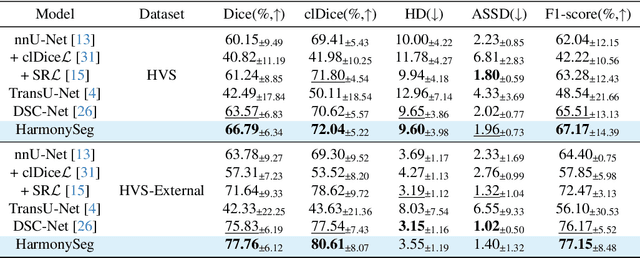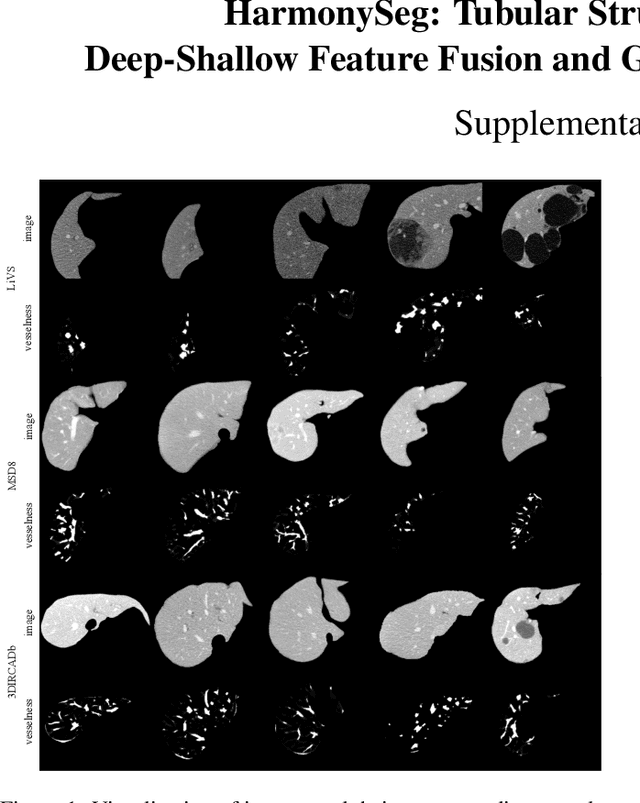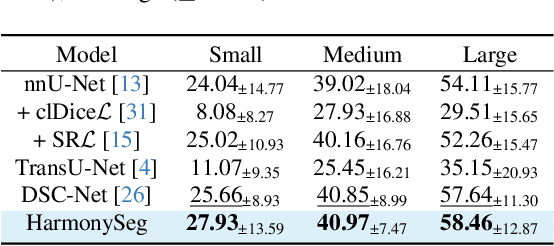Yuanyuan Wang
TinyUSFM: Towards Compact and Efficient Ultrasound Foundation Models
Oct 22, 2025Abstract:Foundation models for medical imaging demonstrate superior generalization capabilities across diverse anatomical structures and clinical applications. Their outstanding performance relies on substantial computational resources, limiting deployment in resource-constrained clinical environments. This paper presents TinyUSFM, the first lightweight ultrasound foundation model that maintains superior organ versatility and task adaptability of our large-scale Ultrasound Foundation Model (USFM) through knowledge distillation with strategically curated small datasets, delivering significant computational efficiency without sacrificing performance. Considering the limited capacity and representation ability of lightweight models, we propose a feature-gradient driven coreset selection strategy to curate high-quality compact training data, avoiding training degradation from low-quality redundant images. To preserve the essential spatial and frequency domain characteristics during knowledge transfer, we develop domain-separated masked image modeling assisted consistency-driven dynamic distillation. This novel framework adaptively transfers knowledge from large foundation models by leveraging teacher model consistency across different domain masks, specifically tailored for ultrasound interpretation. For evaluation, we establish the UniUS-Bench, the largest publicly available ultrasound benchmark comprising 8 classification and 10 segmentation datasets across 15 organs. Using only 200K images in distillation, TinyUSFM matches USFM's performance with just 6.36% of parameters and 6.40% of GFLOPs. TinyUSFM significantly outperforms the vanilla model by 9.45% in classification and 7.72% in segmentation, surpassing all state-of-the-art lightweight models, and achieving 84.91% average classification accuracy and 85.78% average segmentation Dice score across diverse medical devices and centers.
Every Step Evolves: Scaling Reinforcement Learning for Trillion-Scale Thinking Model
Oct 21, 2025Abstract:We present Ring-1T, the first open-source, state-of-the-art thinking model with a trillion-scale parameter. It features 1 trillion total parameters and activates approximately 50 billion per token. Training such models at a trillion-parameter scale introduces unprecedented challenges, including train-inference misalignment, inefficiencies in rollout processing, and bottlenecks in the RL system. To address these, we pioneer three interconnected innovations: (1) IcePop stabilizes RL training via token-level discrepancy masking and clipping, resolving instability from training-inference mismatches; (2) C3PO++ improves resource utilization for long rollouts under a token budget by dynamically partitioning them, thereby obtaining high time efficiency; and (3) ASystem, a high-performance RL framework designed to overcome the systemic bottlenecks that impede trillion-parameter model training. Ring-1T delivers breakthrough results across critical benchmarks: 93.4 on AIME-2025, 86.72 on HMMT-2025, 2088 on CodeForces, and 55.94 on ARC-AGI-v1. Notably, it attains a silver medal-level result on the IMO-2025, underscoring its exceptional reasoning capabilities. By releasing the complete 1T parameter MoE model to the community, we provide the research community with direct access to cutting-edge reasoning capabilities. This contribution marks a significant milestone in democratizing large-scale reasoning intelligence and establishes a new baseline for open-source model performance.
DualSpeechLM: Towards Unified Speech Understanding and Generation via Dual Speech Token Modeling with Large Language Models
Aug 12, 2025Abstract:Extending pre-trained Large Language Models (LLMs)'s speech understanding or generation abilities by introducing various effective speech tokens has attracted great attention in the speech community. However, building a unified speech understanding and generation model still faces the following challenges: (1) Due to the huge modality gap between speech tokens and text tokens, extending text LLMs to unified speech LLMs relies on large-scale paired data for fine-tuning, and (2) Generation and understanding tasks prefer information at different levels, e.g., generation benefits from detailed acoustic features, while understanding favors high-level semantics. This divergence leads to difficult performance optimization in one unified model. To solve these challenges, in this paper, we present two key insights in speech tokenization and speech language modeling. Specifically, we first propose an Understanding-driven Speech Tokenizer (USTokenizer), which extracts high-level semantic information essential for accomplishing understanding tasks using text LLMs. In this way, USToken enjoys better modality commonality with text, which reduces the difficulty of modality alignment in adapting text LLMs to speech LLMs. Secondly, we present DualSpeechLM, a dual-token modeling framework that concurrently models USToken as input and acoustic token as output within a unified, end-to-end framework, seamlessly integrating speech understanding and generation capabilities. Furthermore, we propose a novel semantic supervision loss and a Chain-of-Condition (CoC) strategy to stabilize model training and enhance speech generation performance. Experimental results demonstrate that our proposed approach effectively fosters a complementary relationship between understanding and generation tasks, highlighting the promising strategy of mutually enhancing both tasks in one unified model.
GlobalBuildingAtlas: An Open Global and Complete Dataset of Building Polygons, Heights and LoD1 3D Models
Jun 04, 2025



Abstract:We introduce GlobalBuildingAtlas, a publicly available dataset providing global and complete coverage of building polygons, heights and Level of Detail 1 (LoD1) 3D building models. This is the first open dataset to offer high quality, consistent, and complete building data in 2D and 3D form at the individual building level on a global scale. Towards this dataset, we developed machine learning-based pipelines to derive building polygons and heights (called GBA.Height) from global PlanetScope satellite data, respectively. Also a quality-based fusion strategy was employed to generate higher-quality polygons (called GBA.Polygon) based on existing open building polygons, including our own derived one. With more than 2.75 billion buildings worldwide, GBA.Polygon surpasses the most comprehensive database to date by more than 1 billion buildings. GBA.Height offers the most detailed and accurate global 3D building height maps to date, achieving a spatial resolution of 3x3 meters-30 times finer than previous global products (90 m), enabling a high-resolution and reliable analysis of building volumes at both local and global scales. Finally, we generated a global LoD1 building model (called GBA.LoD1) from the resulting GBA.Polygon and GBA.Height. GBA.LoD1 represents the first complete global LoD1 building models, including 2.68 billion building instances with predicted heights, i.e., with a height completeness of more than 97%, achieving RMSEs ranging from 1.5 m to 8.9 m across different continents. With its height accuracy, comprehensive global coverage and rich spatial details, GlobalBuildingAltas offers novel insights on the status quo of global buildings, which unlocks unprecedented geospatial analysis possibilities, as showcased by a better illustration of where people live and a more comprehensive monitoring of the progress on the 11th Sustainable Development Goal of the United Nations.
HarmonySeg: Tubular Structure Segmentation with Deep-Shallow Feature Fusion and Growth-Suppression Balanced Loss
Apr 10, 2025



Abstract:Accurate segmentation of tubular structures in medical images, such as vessels and airway trees, is crucial for computer-aided diagnosis, radiotherapy, and surgical planning. However, significant challenges exist in algorithm design when faced with diverse sizes, complex topologies, and (often) incomplete data annotation of these structures. We address these difficulties by proposing a new tubular structure segmentation framework named HarmonySeg. First, we design a deep-to-shallow decoder network featuring flexible convolution blocks with varying receptive fields, which enables the model to effectively adapt to tubular structures of different scales. Second, to highlight potential anatomical regions and improve the recall of small tubular structures, we incorporate vesselness maps as auxiliary information. These maps are aligned with image features through a shallow-and-deep fusion module, which simultaneously eliminates unreasonable candidates to maintain high precision. Finally, we introduce a topology-preserving loss function that leverages contextual and shape priors to balance the growth and suppression of tubular structures, which also allows the model to handle low-quality and incomplete annotations. Extensive quantitative experiments are conducted on four public datasets. The results show that our model can accurately segment 2D and 3D tubular structures and outperform existing state-of-the-art methods. External validation on a private dataset also demonstrates good generalizability.
UniSep: Universal Target Audio Separation with Language Models at Scale
Mar 31, 2025



Abstract:We propose Universal target audio Separation (UniSep), addressing the separation task on arbitrary mixtures of different types of audio. Distinguished from previous studies, UniSep is performed on unlimited source domains and unlimited source numbers. We formulate the separation task as a sequence-to-sequence problem, and a large language model (LLM) is used to model the audio sequence in the discrete latent space, leveraging the power of LLM in handling complex mixture audios with large-scale data. Moreover, a novel pre-training strategy is proposed to utilize audio-only data, which reduces the efforts of large-scale data simulation and enhances the ability of LLMs to understand the consistency and correlation of information within audio sequences. We also demonstrate the effectiveness of scaling datasets in an audio separation task: we use large-scale data (36.5k hours), including speech, music, and sound, to train a universal target audio separation model that is not limited to a specific domain. Experiments show that UniSep achieves competitive subjective and objective evaluation results compared with single-task models.
Every FLOP Counts: Scaling a 300B Mixture-of-Experts LING LLM without Premium GPUs
Mar 07, 2025



Abstract:In this technical report, we tackle the challenges of training large-scale Mixture of Experts (MoE) models, focusing on overcoming cost inefficiency and resource limitations prevalent in such systems. To address these issues, we present two differently sized MoE large language models (LLMs), namely Ling-Lite and Ling-Plus (referred to as "Bailing" in Chinese, spelled B\v{a}il\'ing in Pinyin). Ling-Lite contains 16.8 billion parameters with 2.75 billion activated parameters, while Ling-Plus boasts 290 billion parameters with 28.8 billion activated parameters. Both models exhibit comparable performance to leading industry benchmarks. This report offers actionable insights to improve the efficiency and accessibility of AI development in resource-constrained settings, promoting more scalable and sustainable technologies. Specifically, to reduce training costs for large-scale MoE models, we propose innovative methods for (1) optimization of model architecture and training processes, (2) refinement of training anomaly handling, and (3) enhancement of model evaluation efficiency. Additionally, leveraging high-quality data generated from knowledge graphs, our models demonstrate superior capabilities in tool use compared to other models. Ultimately, our experimental findings demonstrate that a 300B MoE LLM can be effectively trained on lower-performance devices while achieving comparable performance to models of a similar scale, including dense and MoE models. Compared to high-performance devices, utilizing a lower-specification hardware system during the pre-training phase demonstrates significant cost savings, reducing computing costs by approximately 20%. The models can be accessed at https://huggingface.co/inclusionAI.
Is Your Autonomous Vehicle Safe? Understanding the Threat of Electromagnetic Signal Injection Attacks on Traffic Scene Perception
Jan 09, 2025Abstract:Autonomous vehicles rely on camera-based perception systems to comprehend their driving environment and make crucial decisions, thereby ensuring vehicles to steer safely. However, a significant threat known as Electromagnetic Signal Injection Attacks (ESIA) can distort the images captured by these cameras, leading to incorrect AI decisions and potentially compromising the safety of autonomous vehicles. Despite the serious implications of ESIA, there is limited understanding of its impacts on the robustness of AI models across various and complex driving scenarios. To address this gap, our research analyzes the performance of different models under ESIA, revealing their vulnerabilities to the attacks. Moreover, due to the challenges in obtaining real-world attack data, we develop a novel ESIA simulation method and generate a simulated attack dataset for different driving scenarios. Our research provides a comprehensive simulation and evaluation framework, aiming to enhance the development of more robust AI models and secure intelligent systems, ultimately contributing to the advancement of safer and more reliable technology across various fields.
How Certain are Uncertainty Estimates? Three Novel Earth Observation Datasets for Benchmarking Uncertainty Quantification in Machine Learning
Dec 09, 2024



Abstract:Uncertainty quantification (UQ) is essential for assessing the reliability of Earth observation (EO) products. However, the extensive use of machine learning models in EO introduces an additional layer of complexity, as those models themselves are inherently uncertain. While various UQ methods do exist for machine learning models, their performance on EO datasets remains largely unevaluated. A key challenge in the community is the absence of the ground truth for uncertainty, i.e. how certain the uncertainty estimates are, apart from the labels for the image/signal. This article fills this gap by introducing three benchmark datasets specifically designed for UQ in EO machine learning models. These datasets address three common problem types in EO: regression, image segmentation, and scene classification. They enable a transparent comparison of different UQ methods for EO machine learning models. We describe the creation and characteristics of each dataset, including data sources, preprocessing steps, and label generation, with a particular focus on calculating the reference uncertainty. We also showcase baseline performance of several machine learning models on each dataset, highlighting the utility of these benchmarks for model development and comparison. Overall, this article offers a valuable resource for researchers and practitioners working in artificial intelligence for EO, promoting a more accurate and reliable quality measure of the outputs of machine learning models. The dataset and code are accessible via https://gitlab.lrz.de/ai4eo/WG_Uncertainty.
SAM-MPA: Applying SAM to Few-shot Medical Image Segmentation using Mask Propagation and Auto-prompting
Nov 26, 2024Abstract:Medical image segmentation often faces the challenge of prohibitively expensive annotation costs. While few-shot learning offers a promising solution to alleviate this burden, conventional approaches still rely heavily on pre-training with large volumes of labeled data from known categories. To address this issue, we propose leveraging the Segment Anything Model (SAM), pre-trained on over 1 billion masks, thus circumventing the need for extensive domain-specific annotated data. In light of this, we developed SAM-MPA, an innovative SAM-based framework for few-shot medical image segmentation using Mask Propagation-based Auto-prompting. Initially, we employ k-centroid clustering to select the most representative examples for labelling to construct the support set. These annotated examples are registered to other images yielding deformation fields that facilitate the propagation of the mask knowledge to obtain coarse masks across the dataset. Subsequently, we automatically generate visual prompts based on the region and boundary expansion of the coarse mask, including points, box and a coarse mask. Finally, we can obtain the segmentation predictions by inputting these prompts into SAM and refine the results by post refinement module. We validate the performance of the proposed framework through extensive experiments conducted on two medical image datasets with different modalities. Our method achieves Dices of 74.53%, 94.36% on Breast US, Chest X-ray, respectively. Experimental results substantiate that SAM-MPA yields high-accuracy segmentations within 10 labeled examples, outperforming other state-of-the-art few-shot auto-segmentation methods. Our method enables the customization of SAM for any medical image dataset with a small number of labeled examples.
 Add to Chrome
Add to Chrome Add to Firefox
Add to Firefox Add to Edge
Add to Edge